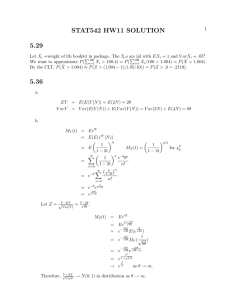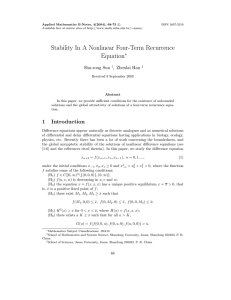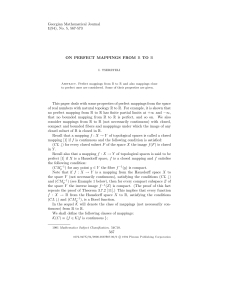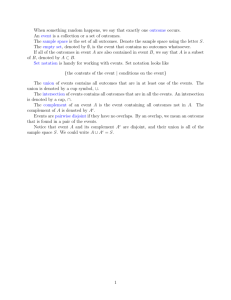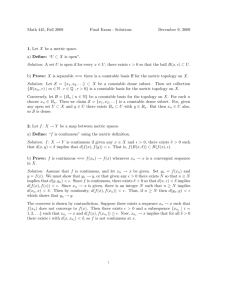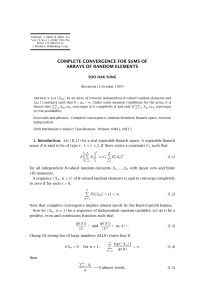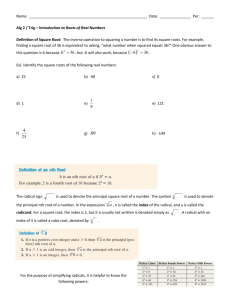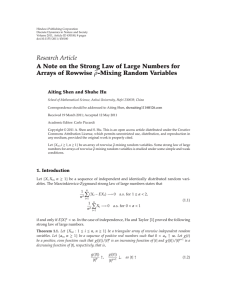Notation
advertisement
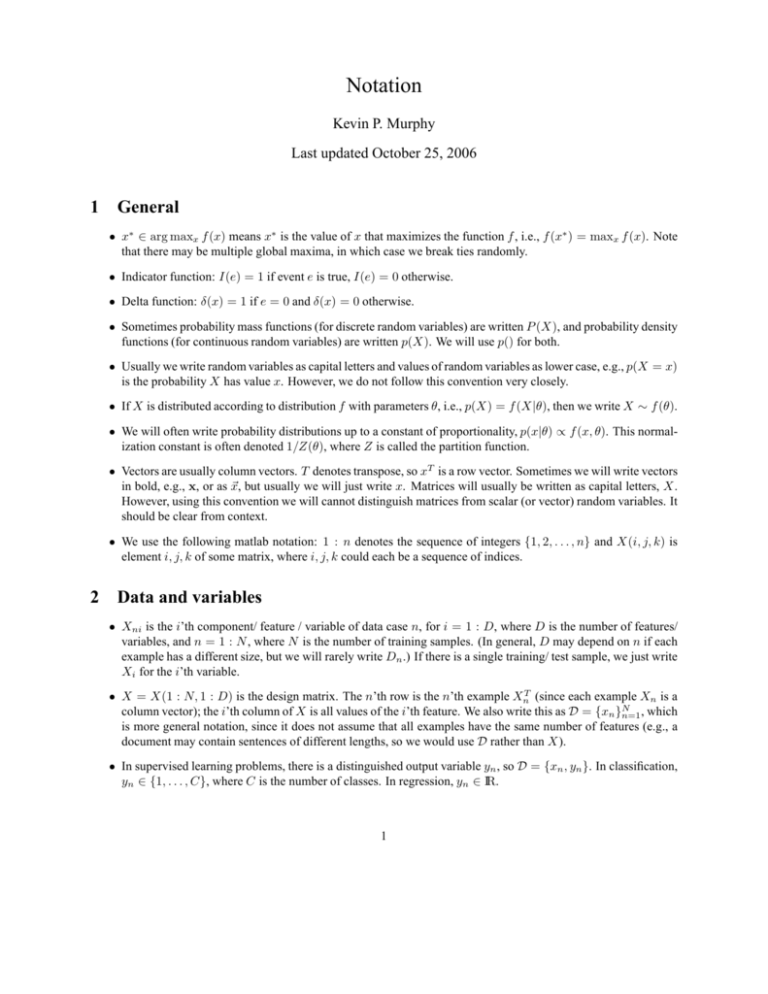
Notation
Kevin P. Murphy
Last updated October 25, 2006
1 General
• x∗ ∈ arg maxx f (x) means x∗ is the value of x that maximizes the function f , i.e., f (x∗ ) = maxx f (x). Note
that there may be multiple global maxima, in which case we break ties randomly.
• Indicator function: I(e) = 1 if event e is true, I(e) = 0 otherwise.
• Delta function: δ(x) = 1 if e = 0 and δ(x) = 0 otherwise.
• Sometimes probability mass functions (for discrete random variables) are written P (X), and probability density
functions (for continuous random variables) are written p(X). We will use p() for both.
• Usually we write random variables as capital letters and values of random variables as lower case, e.g., p(X = x)
is the probability X has value x. However, we do not follow this convention very closely.
• If X is distributed according to distribution f with parameters θ, i.e., p(X) = f (X|θ), then we write X ∼ f (θ).
• We will often write probability distributions up to a constant of proportionality, p(x|θ) ∝ f (x, θ). This normalization constant is often denoted 1/Z(θ), where Z is called the partition function.
• Vectors are usually column vectors. T denotes transpose, so xT is a row vector. Sometimes we will write vectors
in bold, e.g., x, or as ~x, but usually we will just write x. Matrices will usually be written as capital letters, X.
However, using this convention we will cannot distinguish matrices from scalar (or vector) random variables. It
should be clear from context.
• We use the following matlab notation: 1 : n denotes the sequence of integers {1, 2, . . . , n} and X(i, j, k) is
element i, j, k of some matrix, where i, j, k could each be a sequence of indices.
2 Data and variables
• Xni is the i’th component/ feature / variable of data case n, for i = 1 : D, where D is the number of features/
variables, and n = 1 : N , where N is the number of training samples. (In general, D may depend on n if each
example has a different size, but we will rarely write Dn .) If there is a single training/ test sample, we just write
Xi for the i’th variable.
• X = X(1 : N, 1 : D) is the design matrix. The n’th row is the n’th example XnT (since each example Xn is a
column vector); the i’th column of X is all values of the i’th feature. We also write this as D = {xn }N
n=1 , which
is more general notation, since it does not assume that all examples have the same number of features (e.g., a
document may contain sentences of different lengths, so we would use D rather than X).
• In supervised learning problems, there is a distinguished output variable yn , so D = {xn , yn }. In classification,
yn ∈ {1, . . . , C}, where C is the number of classes. In regression, yn ∈ IR.
1
• If Xni is a scalar, then Xni ∈ IR or Xni ∈ IR+ . If it is a vector, then Xni ∈ IRK , where Xnik is the k’th
component of the i’th variable for k = 1 : K, where K is the dimensionality of each variable. (In general, K
may depend on i, but we rarely write Ki ).
• If Xni is binary, then Xni ∈ {0, 1} . If Xni is categorical, then Xni ∈ {1, . . . , K}, where K is the number
of states of variable i. (In general, K may depend on i, but we rarely write Ki ). We write Xni = k if the i’th
variable is in state k, where k ∈ 1 : K. Sometimes you will see a 1-of-K encoding, where Xni ∈ {0, 1}K ,
where Xnik = I(Xni = k). We also use j to index states, mostly of variables that are “parents” of Xi .
3 Bernoullis and multinomials
• We define the Bernoulli distribution X ∼ Be(θ) for X ∈ {0, 1} by
Be(X|θ) = θX (1 − θ)1−X
(1)
We
sufficient statistics for a Bernoulli distribution by the number of heads and tails: N1 =
P denote the minimalP
I(X
=
1),
N
=
n
0
n I(Xn = 0). Alternatively, we can use N1 and N = N1 + N0 .
n
• We define the multinomial distribution X ∼ M u(θ) for X ∈ {1, . . . , K} by
M u(X|θ) =
K
Y
I(X=j)
θj
(2)
j=1
Put another
way, p(X = j|θ) = θj . We denote the sufficient statistics for a multinomial distribution by
P
Nj = n I(Xn = j).
• We define the Beta distribution θ ∼ Beta(α1 , α0 ) for θ ∈ [0, 1] by
Beta(θ|α1 , α0 ) =
Γ(α1 + α0 ) α1 −1
θ
(1 − θ)α0 −1
Γ(α1 )Γ(α0 )
(3)
where Γ(x) is the gamma function. Here α0 , α1 ∈ IR+ are called hyper parameters (pseudo counts) and
α = α0 + α1 is the equivalent sample size (strenght) of the prior.
• We define the Dirichlet distribution θ ∼ Dir(α1 , . . . , αK ) for θ ∈ [0, 1]K by
Dir(θ|α1 , . . . , αK ) ∝
K
Y
α −1
θj j
(4)
j=1
Here αj ∈ IR+ are called hyper parameters (pseudo counts) and α =
P
j
αj is the equivalent sample size.
• We define the likelihood as
L(θ) = p(D|θ)
(5)
`(θ) = log p(D|θ)
(6)
and the log-likelihood as
• We denote the maximum likelihood estimate by
θ̂ML ∈ arg max p(D|θ)
θ
(7)
We denote the maximum a posterior estimate by
θ̂MAP ∈ arg max p(D|θ)p(θ)
θ
(8)
We denote the posterior mean estimate by
θ̂mean = E[θ|D]
2
(9)
4 Naive Bayes classifier
• The 1d Gaussian density is denoted N (x|µ, σ).
• In a generative classifer, the class prior is usually denoted p(Y = c) = πc , if we assume Y has a multinomial
distribution.
• In the naive Bayes model, we have
p(x|y = c) =
D
Y
p(xi |y = c)
(10)
i=1
In the case of K-ary features, we have
p(xi |y = c) =
Y
I(Xi =k)
θick
(11)
k
where θick = P (Xi = k|Y = c). The sufficient statistics are Nick , which is the number of times Xi = k
amongst those training cases where Y = c. In the case of binary features, we have
I(Xi =1)
p(xi |y = c) = θic
(1 − θic )I(Xi =0)
(12)
where θic = P (Xi = 1|Y = c). The sufficient statistics are Nic1 , the number of times Xi = 1 amongst cases
where Y = c, and Nic = Nc , the number of times Xi = 0 or Xi = 1 in cases where Y = c.
5 Markov chains
i
= p(Xi = k|Xi−1 = j), which is independent of i if the chain is stationary. The
• The transition matrix is Tjk
PN PD
sufficient statistics to estimate this are the observed number of j→k transitions: Njk = n=1 i=2 I(Xni =
k, Xni−1 = j). There is no i index since we assume the parameters are shared (tied) across time.
• The initial state distribution is πk1 = p(X1 = k).
• The stationary distribution is π which satisfies πT = π (if we treat π as a row vector).
6 Information theory
• The entropy of a random variable X ∈ 1 : K with discrete distribution p is denoted by
H(p) = H(X) = −
K
X
p(X = k) log2 p(X = k) = −
k=1
X
pk log pk
(13)
k
The joint entropy is denoted H(X, Y ) and the conditional entropy as H(X|Y ). The mutual information is
denoted I(X, Y ) (often written as I(X; Y )). The Kullback-Leibler divergence between two distributions is
denoted KL(p||q).
3
